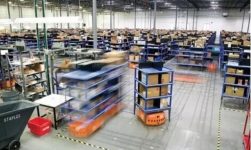
Successful application cases of RFID technology in the logistics supply chain
[ad_1]

1. Application background:
At present, the supply chain has become a key area of competition among enterprises, and the integration and management of the supply chain also means that enterprises will face a series of new technological challenges.
Factors such as intensified market competition and variability in demand
Prompt product production and sales traders must continue to accelerate the pace of progress, launch personalized and flexibly configurable products, ensure promises, deliver on time, and quickly respond to the changing requirements, hobbies of customers and the external economic competition environment. In supply chain solutions, speed, efficiency, accuracy, and information integration are the key goals pursued by the program.
Reasonable and efficient supply chain management can capture customer needs
Sharing information in the entire supply chain enables companies to accurately predict the possibility of inventory shortages and replenish them in a timely manner to avoid any delays that may result, and ensure the synchronization of planning and execution from start to finish. Through the synergy of the supply chain, companies can reduce the scale of inventory, shorten the return period of investment, improve the quality of products and services, and accelerate the company’s response to the market.
Supply chain refers to the movement process of all physical objects from raw materials to end users. Including supplier selection, purchasing, product planning, material processing, order processing, inventory management, packaging, transportation, warehousing and customer service. Successful supply chain management can seamlessly integrate all partners into the supply chain.
In supply chain management, the most critical technology is cargo tracking
At present, the information identification and tracking technology commonly used in supply chain management systems is barcode technology. The various deficiencies of barcode technology, such as only one label at a time, limited data volume, poor environmental adaptability, and the same product with the same barcode, limit the efficiency of the supply chain. The improvement.
2. Advantages of RFID solution
RFID is a radio frequency data collection technology and the best means of tracking goods. It is superior to bar code recognition technology in that RFID can dynamically identify high-speed moving objects and can simultaneously identify multiple electronic tags, with a large identification distance and adaptability. Harsh environment. At the same time, because the electronic tag can uniquely identify the goods, it is possible to track the goods in the entire supply chain, and to know where the goods are in the supply chain in real time.
The implementation of the electronic label system solution can achieve the following goals and obtain the expected economic benefits:
1. Shorten the operation process
2. Improve the quality of inventory operations
3. Increase the throughput of the distribution center
4. Reduce operating costs
5. Logistics tracking in the supply chain
6. Increase the transparency of supply chain management
7. Capture data on the process
8. The transmission of information is faster, more accurate and safer.
Three, system introduction
(1) Packing and labeling system
Before the goods are put into storage, set up the packing area (this step can also be completed on the product production line).
According to the actual warehouse management application requirements, the corresponding single products are packed into independent packages according to the specified quantity, the operation information is written into the label, and the label and the box are hung or pasted.
(2) Inbound and outbound inspection system
1. System composition:
Access RFID Station: fixed reader/antenna, sensor system, process controller, indicator light, alarm, indicator panel (indicating receipt and delivery information, loading information, etc.)
Label selection and installation: pallet label RPC, box label (adhesive type)
2. The benefits of RFID to warehouse management
(1) Management personnel can grasp the status of inventory materials in real time, and realize the information transparent asset management method
(2) There is no need to implement traditional inventory work, thereby reducing the backlog of materials, speeding up capital turnover, and facilitating production guidance
(3) Solve the traditional management mode that is prone to human errors and untimely information exchange in manual statistics
(4) Reduce the workload of manual statistics and improve work efficiency
(5) Prevent the occurrence of misconduct by technical means
(3) Forklift stacking and picking system
1. System composition
Forklift stacking and picking RFID Station: On-board terminal (WLAN), Reader/antenna,
Label selection and installation: pallet label RPC
2. Typical application process
Forklift stacking and picking systems are usually applied to pallets and large containers, and the reader/antenna is connected to an industrial-grade vehicle-mounted terminal (built-in WLAN).
3. Application revenue
It can automatically target pallet stacking and picking, improving pallet cargo handling, planning, and forecasting capabilities.
(4) Inventory
The staff uses a handheld terminal to read the data in the pallet label. The pallet label records the actual number of goods carried by the pallet. Real-time data transmission can be realized through the wireless network, or the data can be collected in batches after half a day. The processing method is transferred to the background management system. Therefore, through the automatic collection method of RFID technology, fully automatic real-time, partitioned inventory without manual intervention can be realized, and the rapid inventory operation and the accuracy of the inventory data can be ensured.
4. Successful application cases of RFID technology in the logistics supply chain
RFID (Radio Frequency Identification) inventory tracking system refers to the automatic storage and transmission of information such as component specifications and serial numbers by attaching RFID tags to pallets, boxes or components. RFID tags can transmit information to radio frequency readers within 10 feet, so that warehouses and workshops no longer need to use handheld barcode readers to scan barcodes for components and products one by one, which reduces omissions to a certain extent. Occurred, and greatly improved work efficiency. The application of RFID can significantly cut costs and clear up obstacles in the supply chain. This technology is closely linked to the logistics supply chain and is expected to replace barcode scanning technology in the next few years.
[ad_2]



